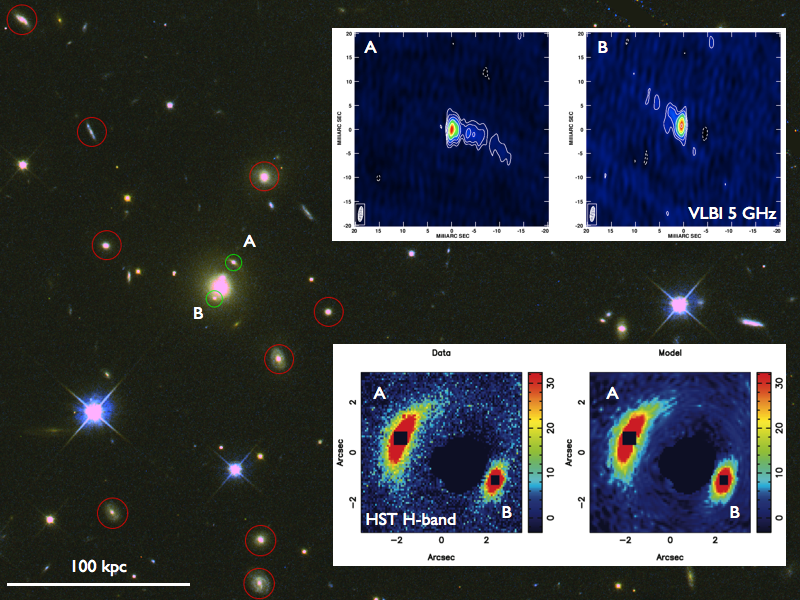Daily Image
19-08-2010Gravitational lensing by a group of galaxies
| Submitter: | John McKean |
| Description: | B2108+213 (shown by the green circles in the HST colour plot) is a z = 0.67 flat-spectrum radio source that is gravitationally lensed into two images (A and B; 4.5 arcsec separation) by a group of galaxies at z = 0.365. The main part of the lens is a massive elliptical cD galaxy that sits between the two lensed images at the centre of the group. From imaging and spectroscopy with the 10-m Keck optical telescope on Hawaii, 52 group members have been found so far (some of these are circled red). What makes this lens system so interesting is that the lens is a compact group of galaxies and that the lensed images go straight through the core of the group. This allows for the first time the mass distribution of a group-scale dark matter halo to be investigated. A lensing mass model, that included the group members, was constructed using the extended radio emission of the lensed sources that was found from VLBI imaging (top insert). These data gave an accurate mass estimate within a radius of ~12 kpc from the group centre. A high signal-to-noise optical spectrum, also from Keck, allowed the steller dynamics of the main lensing galaxy to be determined. By combining the lensing and stellar dynamics data, the inner density profile of the group was found to go as ~ r^-2.5. For dark matter dominated systems, like clusters, this profile is expected to go as r^-1, whereas for galaxies it is r^-2. The extended optical emission from the host galaxy of the background quasar was also analyzed using a state-of-the-art grid-based lensing code (bottom insert; note that the lensing galaxy has been removed, the bright quasar emission has been masked and the image is rotated by about 90 degrees counter-clock wise). The lens model is found to reproduce the observed HST infra-red imaging very well. The result of this analysis confirmed the steep mass profile for the B2108+213 group. This suggests that the mass distribution is dominated by the baryons in the centre and not by the dark matter, as is the case for cluster-scale haloes. Further details of this work can be found in More et al. (2008, MNRAS, 384, 1701) and McKean et al. (2010, MNRAS, 404, 749) |
| Copyright: | John McKean |
| Tweet |  |
